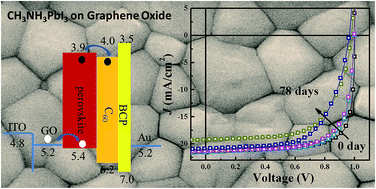Graphene oxide as an efficient hole-transporting material for high-performance perovskite solar cells with enhanced stability†
Abstract
In recently developed high-efficiency metal organometal halide perovskite solar cells (PVSCs), electron and hole transporting materials have shown key roles in determining the growth of perovskite crystals, as well as the performance and stability of the device. However, interlayer materials which can facilitate both high efficiency and stability at low cost are still limited. Here, we demonstrate that, by controlling the thickness of solution-processed graphene oxide (GO), one can achieve a balance of high work function and conductivity. Using GO with the optimized thickness as a hole-transporting material (HTM) in PVSCs, a high power conversion efficiency (PCE) of 16.5% with no hysteresis has been achieved with excellent light-soaking photocurrent stability in comparison with a commonly used organic-based HTM. Under high humidity and continuous light soaking, the encapsulated perovskite devices retained >80% of their initial efficiency for >2000 h. Detailed studies on the GO binding energy, charge transfer efficiency with perovskite, and crystal morphology shed light on the origin of the observed improvement in photovoltaic performance. Benefiting from the merits of low temperature, solution processability and low cost, the proposed GO fabrication methods could aid scalable production of PVSCs with high PCE and excellent stability.



 Please wait while we load your content...
Please wait while we load your content...